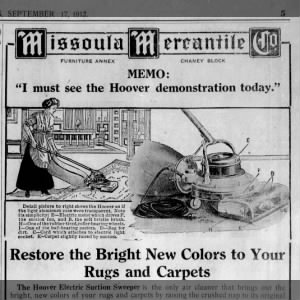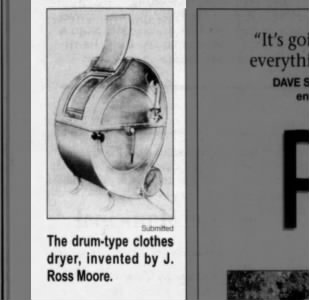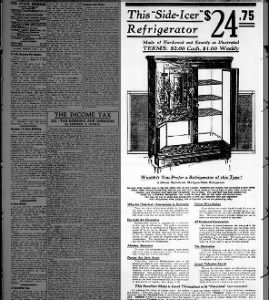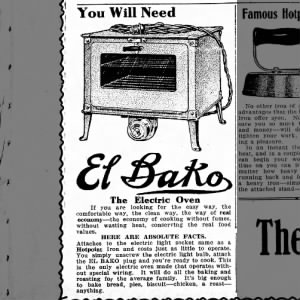
In 1910, it took 12 hours a day to do the housework (six hours for cooking alone)! Domestic chores were no walk in the park. Take a look at these ads for newly invented household appliances from the early 1900’s. These time-saving devices would revolutionize domestic life!

The Hoover Suction Sweeper: The first upright vacuum was invented by James M. Spangler, a janitor at an Ohio department store. He rigged a device to clean floors then filed a patent for his design. Spangler sold the patent to his cousin’s wife, William Henry Hoover. Hoover improved the design and started the “Electric Suction Sweeper Company.”
The Thor Washing Machine: In 1909, women swooned over Thor – the washing machine not the superhero! The Thor washing machine was an electric powered washing machine that took the place of galvanized tubs, washboards and elbow grease. It revolutionized wash day in America!

Clothes Dryer: Tired of not being able to hang laundry out to dry in frigid North Dakota winters, J. Ross Moore invented the clothes dryer. The dryers were sold under the name “June Day” beginning in 1938.
Hot Point Iron: In 1910, a company called Hotpoint developed an electric iron that was hotter at the tip making it easier to iron ruffles and around button holes. Soon everyone wanted the iron with the hot point!

Refrigerator: This 1913 refrigerator shows the latest and greatest in refrigeration technology. These icebox type refrigerators kept food cool with blocks of ice that needed to be replenished regularly.
Electric Refrigerator: By 1918, Frigidaire started mass producing electric refrigerators for home use – and no ice required!
Electric Dishwasher: Tired of washing dishes? In 1920, you could wheel in this portable electric dishwasher, load it and press a button. Voila!

Electric Oven: For about $10, families could buy this 1913 “El Bako” countertop electric oven. It was 14-inches square and constructed of one-inch thick steel walls to maintain heat. It had three heat levels: low, medium and high.
Does your family have any of grandma’s old appliances kicking around? Tell us about it and search our archives for other fun finds!


I still have a 33 lp that back in the day if you wrote a song and wanted it recorded, you sent the song out with payment of 25 cents and they made those lyrics into a song. This was my grandmothers who was deceased before I was born. It’s called-There’s a little bit of bad in every good little girl.
My grandmothers both had wringer washers, where you feed the clothes through wringers to squeeze out the water before you put them in a second tub filled with rinse water
My mother had a Maytag ringer washer. It had a gasoline motor. We didn’t have electricity until about 1950. Then we got Rural Electric Cooperative. One light in the middle of each room with a string attached to turn it on, and I think maybe one or two plug-ins.
“Spangler sold the patent to his cousin’s wife, ”
Maybe “his wife’s cousin”?
LOL. Maybe William, “his cousin’s wife,” was out of the closet???? Someone needed to proofread this.
What is wrong with that statement? The gender of his cousin is not specificed; ergo, probably a male cousin, so “his cousin’s wife” is not a problematic statement.
“Spangler sold the patent to his cousin’s wife, William Henry Hoover.” His cousin’s wife is named William Henry Hoover? I do think there is something wrong with this sentence.
You’re right, talisema; I misread the sentence, or my eye skipped a line or some such “senior moment.”
My earliest memory of a washing machine, ca 1955, was of a vertical cylinder with those rollers on top. They were there because there was no spin cycle; the excess of water was squeezed out by running the clothes through the rollers (called in some places a “mangle”) One hoped that most of the wrinkles would work out while drying on the line.
Bear in mind that most of this was unavilable to many people because, until the Rural Electrification program and the dam building programs, electricity was not available in large parts of the country, an expensive luxury in many other parts.
Left out a key phrase, The Rural Elecrtification program was the product of the New Deal and the dam building was started under Hoover, but those were largely completed and the activity extended into the south (TVA) under FDR.
The “Mangle rollers” were for ironing. They were heated.
Sheets used to be ironed with a mangle.
My grandmother had one.
Gwen
I used a mangle in a Hotel I worked at…It was for Ironing Sheets & Pillow cases…It consisted of a Large Hot Roller which was padded…and the top Metal Curved Iron was lowered down on the pre-folded Sheets and Pillow cases…the steam that came off those sheets almost made you pass out…
You’re right!. The rollers on the washing machines were called “wringers”. My mother got her hand caught in them when she was a child. The saying, “run through the wringer” came from this machine. I remember my mother using a wringer washer up until 1955. I was born in 1943.
Back in the 194Os, we had a gas washing machine. My mother heated the wash water in galvanized tubs by sitting it out in the sun. She laid the sheets on the grass to whiten them and dry them. The chlorine in the grass did the job. This had to be done early in the morning when the due was on the grass. We also had an iron that was heated by placing hot coals inside it. We lived in the country, in Connecticut. As a young mother, l had a winger washing machine. It took several hours to do laundry. I love the convenience and time saving appliances I have now.
My Mother was fortunate enough to have a wash board and a galvanized tub…she did get a gas machine after she was married for two years…we had a clothes line outside that we used for the 1st half of the day…then we brought the frozen clothes in (in winter) and hung them on a clothes horse…when they were just damp, we ironed them with a Flat Iron which was heated on a Wood Stove…It consisted of a wooden Handle with two flat irons…these irons were switched as the first one cooled down…we lived in Northern Saskatchewan, where Electricity wasn’t available until the late 40’s or early 50’s…I really enjoy my electric appliances now…
As a child I got my hand caught in one of those wringers but that one had a safety feature that the wringer rollers would pop open if something too thick tried to go through. Whew!
In the early 40’s my aunt had a washer that had wringers on top. I had to guide the sheets and clothes thru the wringers and was always reminded to watch out for my fingers. I items were too bulky the top wringer would pop up.
My Mother had a mangle for sheets and table clothes but I was not allowed to use it.
I well remember the ice box and the ice man coming carrying big blocks of ice with his ice tongs, I would get in trouble if I opened the refrigerator door letting out the cold air and I was REALLY in trouble if I was caught on a hot summer day chipping ice to suck on.
I also remember the tall telephone with the 4 party system, then later a two party system and then your own private line. If I ever got caught listening on the phone, i would get in big trouble. There was the tall phone and the the rotary phone. And I could go on and on with all the improvements. Life is so easy now.
Water was another chore on Washday…we had a well that was 21 feet deep,,,with a hand pump…or a pail lowered down into the well with a rope…in winter, the hand pump froze up…(a kettle full of Boiling Water would thaw out the pump—sometimes!) water was carried into the house and dumped into a Boiler on the Wood Stove…Wood had to be carried in constantly to keep the Stove hot for cooking and for the wash water…If you were clever enough to haul up enough wood in the Summer months to cut and split it to last the winter…My Grandparents lived 1/2 mile away so we didn’t have a phone…if we had to go any farther,,,we rode horseback or walked…
Our Fridge was an Ice house (like a cellar) that had to be filled with snow early in the spring…the Milk Can was hung on a Spike,,,and everything else was canned or kept in metal containers in the Ice House…even the meat was canned…lots of canning!
I still have my grandmother’s waffle iron. I have no idea how old it is but I’m guessing it was either a wedding gift (1918) or shortly afterward. It still works and I still use it.
Does anyone remember the old Crowley
“Claw Foot” refrigerator? It came with two
steel balls that were heated in boiling water and were placed, one at a time, on the “Claw”! As long as the balls were hot while on the claw, the inside of the refrigerator was cold.
Some wood stoves had a copper coil in the fire box. This coil would be connected to a tank beside the stove! You knew when you had hot water by touching the tank! No insulation!! I still have the floor stand for that “hot water tank”! It was made by a company in Washing Courthouse, Ohio!! Later on someone got the “bright idea” of a kerosene stove! Now very successful, due to the fact that the house and the food REEKED of kerosene odor!! Deodorized kerosene helped very little!!
The old house we lived in was built in 1910! It was wired for electric power provided by a large sawmill. This was DC current! Three lights in the house, one each in bedroom, living room, and kitchen! Not in dining room!
Times have changed and very much improved.
Back in 1957, we had an apartment that had the kerosene stove, with the hot water heater built into it. It did have a strong odor to it, and we had to have the window crack open a bit year round. Sure don’t miss that. Did any of you have a Speed Queen washing machine? It had a separate spinning cylinder to wring the water out of the clothing. It did a good job of cleaning the clothing, but I had to hold down the lid on the spinning cylinder, or it would spin across the room.
I remember the flat my grandparents lived in, in MA. The electric wiring was run through the pipes that were originally for the gaslights.
This is darling. I was in a hurry and almost deleted it, but the domestice memories resonated with me on many levels. We have a 1914 coal stove in our home. Unclear how the hot water is available as pipes come out of it and go ….?
Also, I have my grandmother’s ice chest and my husband’s grandmother’s tredle sewing, a Silvertone “Victrola,” and more. A little bit of serendipity in your article.